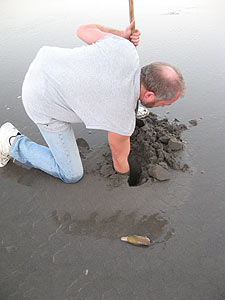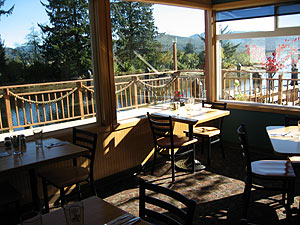 |
Some Oregon Coast Clamming Reopens, Rivers Researched
Published 08/03/2010
 |
| The mouth of the Nestucca River, near Pacific City, where clamming is allowed and researchers will be crawling around soon. |
(Oregon Coast) – The Oregon Department of Agriculture and the Oregon Department of Fish and Wildlife (ODFW) reopened clamming in some areas of the Oregon coast, while two rivers on the north coast are the subject of research.
For those wanting to indulge in recreational razor clamming, that is still closed on most of the coast because of toxins, although the ODFW and Oregon Department of Agriculture reopened clamming throughout Tillamook County and parts of lower Clatsop County. It has reopened from Tillamook Head (Cannon Beach) to Cascade Head (Neskowin, just south of Pacific City). This leaves open the areas in and around Pacific City, Oceanside, Tillamook Bay, Garibaldi, Rockaway Beach, Nehalem Bay, Manzanita, Arch Cape and Cannon Beach.
South of Bandon is also open, all the way down to Brookings.
Everything else is closed to clamming due to elevated shellfish toxin levels.

Shellfish samples taken from the area indicate levels of the marine toxin domoic acid have dropped below the alert level.
Domoic acid is a toxin that happens naturally, and is produced by marine phytoplankton or algae. The toxin cannot be destroyed by cooking, adding baking soda, or any other method.
While many people along Oregon’s North Coast are home sound asleep, researchers from the Oregon Department of Fish and Wildlife will be working late to unlock clues about returning chinook salmon.
Starting this month, ODFW survey teams will be collecting adult chinook that have returned to the Nehalem and Nestucca rivers in order to gain a better understanding of how many salmon survive the arduous round trip from the North Coast to Alaska and back.
 |
| Overlooking the Nehalem River (Pizza Garden, Nehalem) |
Teams working from shore and in boats will use drift nets to catch, mark and release as many chinook as possible. The study is expected to begin by the middle of the month and take place annually from August through October for the next 4-5 years.
Much of the work will happen at night to avoid conflicts with anglers and reduce stress on fish, according to Shelly Miller, project leader stationed at ODFW’s Corvallis Research Lab. In addition, researchers believe working during the wee hours will improve their catch rates and produce more data from which to draw conclusions.
“More fish move at night,” Miller said.
Crews use a number of techniques to reduce stress to the fish, including not handling the fish at all if water temperatures are above about 64 degrees Farenheit.
 |
| Nehalem Bay |
The project leader explained that returning chinook will be collected near the mouths of the two rivers, marked and released to continue their migration to upstream spawning grounds. When those fish are examined a second time during spawning surveys or after being caught on anglers’ rods, the totals will be compared to the number of unmarked chinook to develop a population estimate. No live fish will be handled during the spawning surveys. Only carcasses will be examined for marks.
“This is a common technique for estimating animal populations,” Miller said.
Researchers will supplement their data by conducting angler creel surveys during the daylight hours, counting spawning sites or “redds” when fish are actively spawning and by counting and examining carcasses from the river bottoms after the salmon have completed their life cycles.
Population estimates developed through this research will be used in local management decisions and in broader discussions about salmon under the Pacific Salmon Treaty, according to Chris Knutsen, district fish biologist for ODFW’s North Coast Watershed.
More About Oregon Coast hotels, lodging.....
 |
 |
 |
LATEST OREGON COAST NEWS STORIES
Whale Body Parts Found on Oregon Coast - Two Whales Strand on Washington Coast |
Back to Oregon Coast
Contact Advertise on BeachConnection.net
Secrets of the Season |
Unusual Travel Articles TravelParanormal.com allows you to submit your own creepy tale or debunk one - or see up-to-the-minute news headlines about travel and the paranormal. News Headlines from All Over Oregon Need to scan Oregon headlines? Constantly updated news from all over Oregon: a comprehensive, up-to-the-minute display of news headlines from a variety of media |





































